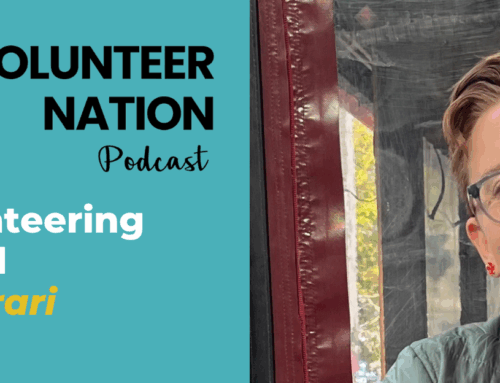 A Riff on Best Practices in Volunteer Management with Nancy Macduff
A Riff on Best Practices in Volunteer Management with Nancy Macduff
Note: A version of this interview on best practices in volunteer management was originally published on December 10, 2010 on our now defunct Tobi’s Nonprofit Management Blog on December 10, 2010.
I was looking through my content archives and came across a fantastic interview with an old friend and colleague, Nancy Macduff, about her thoughts on the future and best practices in volunteer management.
It’s amazing how her insights and observations are still relevant today, a decade later, and even in times of uncertainty. Economic hardship? Check. Volunteers need for meaningful work? Check. Need for greater use of social media and tech to reach volunteers? Check!
While some of the platforms have changed, Nancy’s insights are evergreen.
Nancy is known for her ground-breaking “pracademic” research and writing around the concept of “episodic volunteering,” now a widely-accepted concept amongst leaders of volunteers.
After decades at the helm of her website Volunteer Today, Nancy transitioned to her work as an adjunct professor at Portland State University. She now leads the Volunteer Engagement and Leadership Program (VELP) program, a series of courses that cover the dynamics of creating a successful volunteer management program.
So, let’s check out my interview with Nancy from a decade ago. What’s changed? What’s stayed the same?

Best Practices in Volunteer Management: Interview with Nancy Macduff
After many years, I had the pleasure of reconnecting with Nancy Macduff, a respected colleague and internationally recognized expert on volunteerism. I asked her to share her thoughts on how volunteerism is evolving and how we can all keep up.
She trains and consults for organizations on issues related to volunteer administration and adult learning and has authored numerous books and articles on the topic of best practices in volunteer program administration.
Where is volunteering headed in the future?
- People are increasingly asking organizations to have voluntary tasks that are short in duration, even to the point of dropping in to volunteer or volunteering on cell phone.
- Social media sites will gain in usage by those managing volunteers—Blogs, Twitter, social networking (Facebook), Wiki, and more sophisticated use of email.
- Volunteers are seeking “meaningful” jobs. People are less likely to be attracted to menial tasks, like stuffing envelopes. Many volunteers reaching retirement age are “baby boomers” who want the work they do to make a difference in the world.
- Continued growth in online volunteering tasks. There are now “hotlines” where volunteers “talk” with people via email, rather than phones—as in domestic violence situations or support for those with chronic mental illness.
- Continued growth in international volunteer opportunities.
- Engagement of youth in high school and college, especially, will continue to grow.
- The need for volunteers will grow.
Given today’s economic realities, how should those who manage volunteers adapt?
- Consider when the jobs offered for volunteers were created. If volunteers have been doing the same job since it was created in 1970 you might consider applying it to 21st century realities. Imagine if AT&T had the same jobs it had in 1970. They would be out of business!
- Economic realities are impacting the ability to volunteer. Some people are unemployed and would appreciate the opportunity to volunteer while seeking work. Rarely are these people recruited overtly.
- Many traditional socio-economic groups who were the mainstay of volunteering are suffering financially and people are working two or more jobs. This impacts how people can volunteer.
- Volunteer managers need to collect factual data on these social changes and share them with administrators to educate them about the challenges of recruiting and retaining volunteers over decades.
- Volunteer programs need to increase the capacity to use all forms of social media for everything from volunteer engagement to fundraising.
- In economic uncertainty there is a desire by people to help. Making it as easy as possible for someone to serve will make recruiting easier.
- Flexibility. Hanging on to decades of old practices and jobs, no matter how well they worked in the past, is dangerous. Many fraternal organizations are finding it increasingly difficult to sustain their organizations as they hang onto 20th century traditions. As with everything in life, people want things tailored specifically to them, their needs, values, and availability.
- The economy has reduced staff in all types of organizations—nonprofit, government, and for profit. This has cost some managers of volunteers their job or reduced their time spent on it, as the person takes on additional duties. This shrinking of the time devoted to the engagement and management of volunteers is occurring simultaneously as administrators increase the demand for more volunteers. If an organization wants more volunteers, then volunteers need to be recruited as “middle managers.” This needs to be done in an intentional, planned manner, with position descriptions, training, volunteers attending staff meetings. This turns the manager of volunteers into a delegator, not a “doer.”
Where can volunteer managers find solid information about evidence-based practices that work (versus merely anecdotal stories about good ideas)?
- I would recommend that the professional manager of volunteers belongs to a professional association—a local volunteer managers association (sometimes called a DOVIA-Directors of Volunteers in Agencies) or an AVA (association of volunteer administrators) as in NYAVA. The only national one that exists now is AL!VE. They have a website, webinars, and dues.
- They also need to subscribe to IJOVA-International Journal of Volunteer Administration [Note: IJOVA is now managed by ALIVE and is open source).
- There is also an online journal called eVolunteerism. It is not juried, but she has knowledgeable practitioners and consultants write for it. [Note: The late Susan Ellis was formerly the editor. Rob Jackson has taken leadership as editor in chief.]
- Education and Certification. For the volunteer manager who has 3 or more years of experience there is a certification process – CCVA. Person takes a test to be certified. Enrollment is open at certain times of the year. The other option is university-based programs. In the US, I teach one at Portland State University and it is 100% online. It is the only program where all six classes are devoted to the administration of volunteers. Upon completion there is a professional certificate from the university. There are other classes in volunteer administration, but they are usually part of a major in nonprofit administration.
- More senior managers of volunteers should belong to ARNOVA – Association for Research on Nonprofits and Voluntary Action. Dues provides subscription to Nonprofit and Volunteer Sector Quarterly. The most senior of the journals on volunteer administration and the most academic.
- The other journal I read is Nonprofit Management and Leadership.
- Energize Inc. news and your blog [Note: Since this interview, I’ve replaced my former blog with two new ones – the VolunteerPro blog and the Tobi Johnson & Associates blog where we post weekly articles] are the equivalent of “magazines” and resources on volunteer administration. These are places where you can learn about research by people who tracking it for you. Many national organizations have such sites for their affiliates.
Thank you, Nancy! Good ideas and great resources!
Where Do You Find Your Best Practices in Volunteer Management?
Even today, Nancy’s list of resources are still relevant and excellent sources for ideas and inspiration.
As a nonprofit leader or volunteer manager, what resources do you use to stay current on today’s best practices in volunteer management?
Post them in the comments below.








Leave A Comment